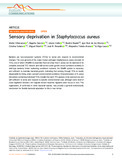Mostrar el registro sencillo del ítem
Sensory deprivation in Staphylococcus aureus
| dc.creator | Villanueva San Martín, Maite | es_ES |
| dc.creator | García Martínez, Begoña | es_ES |
| dc.creator | Valle Turrillas, Jaione | es_ES |
| dc.creator | Rapún Araiz, Beatriz | es_ES |
| dc.creator | Ruiz de los Mozos Aliaga, Igor | es_ES |
| dc.creator | Solano Goñi, Cristina | es_ES |
| dc.creator | Martí, Miguel | es_ES |
| dc.creator | Penadés, José R. | es_ES |
| dc.creator | Toledo Arana, Alejandro | es_ES |
| dc.creator | Lasa Uzcudun, Íñigo | es_ES |
| dc.date.accessioned | 2018-09-05T12:23:28Z | |
| dc.date.available | 2018-09-05T12:23:28Z | |
| dc.date.issued | 2018 | |
| dc.identifier.issn | 2041-1723 | |
| dc.identifier.uri | https://hdl.handle.net/2454/30524 | |
| dc.description.abstract | Bacteria use two-component systems (TCSs) to sense and respond to environmental changes. The core genome of the major human pathogen Staphylococcus aureus encodes 16 TCSs, one of which (WalRK) is essential. Here we show that S. aureus can be deprived of its complete sensorial TCS network and still survive under growth arrest conditions similarly to wild-type bacteria. Under replicating conditions, however, the WalRK system is necessary and sufficient to maintain bacterial growth, indicating that sensing through TCSs is mostly dispensable for living under constant environmental conditions. Characterization of S. aureus derivatives containing individual TCSs reveals that each TCS appears to be autonomous and self-sufficient to sense and respond to specific environmental cues, although some level of cross-regulation between non-cognate sensor-response regulator pairs occurs in vivo. This organization, if confirmed in other bacterial species, may provide a general evolutionarily mechanism for flexible bacterial adaptation to life in new niches. | en |
| dc.description.sponsorship | This work was supported by the Spanish Ministry of Economy and Competitiveness grants BIO2011-30503-C02-02, BIO2014-53530-R, SAF2014-56716-REDT, and RTC-2015-3184-1. J.V. was supported by Ramon y Cajal (RYC-2009-03948) contract from the Spanish Ministry of Economy and Competitiveness. | en |
| dc.format.extent | 12 p. | |
| dc.format.mimetype | application/pdf | en |
| dc.format.mimetype | application/zip | en |
| dc.language.iso | eng | en |
| dc.publisher | Springer Nature | en |
| dc.relation.ispartof | Nature Communications, (2018) 9:523 | en |
| dc.rights | This article is licensed under a Creative Commons Attribution 4.0 International License, which permits use, sharing, adaptation, distribution and reproduction in any medium or format, as long as you give appropriate credit to the original author(s) and the source, provide a link to the Creative Commons license, and indicate if changes were made. The images or other third party material in this article are included in the article’s Creative Commons license, unless indicated otherwise in a credit line to the material. If material is not included in the article’s Creative Commons license and your intended use is not permitted by statutory regulation or exceeds the permitted use, you will need to obtain permission directly from the copyright holder. | en |
| dc.rights.uri | https://creativecommons.org/licenses/by/4.0/ | |
| dc.subject | Sensory deprivation | en |
| dc.subject | Staphylococcus aureus | en |
| dc.subject | Two-component systems | en |
| dc.title | Sensory deprivation in Staphylococcus aureus | en |
| dc.type | info:eu-repo/semantics/article | en |
| dc.type | Artículo / Artikulua | es |
| dc.contributor.department | IdAB. Instituto de Agrobiotecnología / Agrobioteknologiako Institutua | es |
| dc.rights.accessRights | info:eu-repo/semantics/openAccess | en |
| dc.rights.accessRights | Acceso abierto / Sarbide irekia | es |
| dc.identifier.doi | 10.1038/s41467-018-02949-y | |
| dc.relation.projectID | info:eu-repo/grantAgreement/MICINN//BIO2011-30503-C02-02/ES/ | en |
| dc.relation.projectID | info:eu-repo/grantAgreement/MINECO//BIO2014-53530-R/ES/ | en |
| dc.relation.projectID | info:eu-repo/grantAgreement/MINECO//SAF2014-56716-REDT/ES/ | en |
| dc.relation.publisherversion | https://doi.org/10.1038/s41467-018-02949-y | |
| dc.type.version | info:eu-repo/semantics/publishedVersion | en |
| dc.type.version | Versión publicada / Argitaratu den bertsioa | es |
Ficheros en el ítem
Este ítem aparece en la(s) siguiente(s) colección(ones)
La licencia del ítem se describe como This article is licensed under a Creative Commons Attribution 4.0 International License, which permits use, sharing, adaptation, distribution and reproduction in any medium or format, as long as you give appropriate credit to the original author(s) and the source, provide a link to the Creative Commons license, and indicate if changes were made. The images or other third party material in this article are included in the article’s Creative Commons license, unless indicated otherwise in a credit line to the material. If material is not included in the article’s Creative Commons license and your intended use is not permitted by statutory regulation or exceeds the permitted use, you will need to obtain permission directly from the copyright holder.



